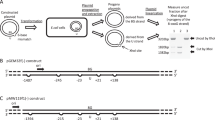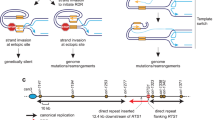Summary
The lesions produced by SOS-dependent mutagens in Escherichia coli are commonly referred to as non-pairing or non-instructive. Although these terms are likely to be appropriate for some lesions, particularly the abasic site, for others, such as the cyclobutane dimer, their suitability is open to question. To address this question, we have compared the error frequencies and spectra that result when a uniquely located T-T sequence, carried in a single-stranded vector, contains either a cis-syn or a trans-syn cyclobutane dimer, or when either the 5′T or 3′T is converted to an abasic site. The data suggest that the high accuracy with which the dimer-containing templates are replicated is unlikely to be the consequence of polymerase preference for the non-instructive insertion of dAMP. Similarly, mis-pairing, rather than non-pairing, is likely to cause mutations. Cyclobutane dimers seem therefore to be misinstructive rather than non-instructive lesions, and the common feature shared by SOS-inducing lesions is more their ability to block replication than inability to form correct base pairs.
Similar content being viewed by others
References
Banerjee SK, Christensen RB, Lawrence CW, LeClerc JE (1988) Frequency and spectrum of mutations produced by a single cis-syn thymine-thymine cyclobutane dimer in a single-stranded vector. Proc Natl Acad Sci USA 85:8141–1845
Banerjee SK, Borden A, Christensen RB, LeClerc JE, Lawrence CW (1990) SOS-dependent replication past a single trans-syn T-T cyclobutane dimer gives a different mutation spectrum and increased error compared to replication past this lesion in uninduced cells. J Bacteriol 172:2105–2112
Boiteux S, Villani G, Spadari S, Zambrano F, Radman M (1978) Making and correcting errors in DNA synthesis: In vitro studies of mutagenesis. In: Hanawalt PC, Friedberg EC, Fox CF (eds) DNA repair mechanisms. Academic Press, New York, pp 73–84
Fersht AR, Knill-Jones JW (1983) Contribution of 3′-5′ exonuclease activity of DNA polymerase III holoenzyme from Escherichia coli to specificity. J Mol Biol 165:669–682
Kemmink J, Bodons R, Konig T, van der Marel GA, van Boom JH, Kaptein R (1987) NMR study of the exchangeable protons of the duplex \({\text{d(GCG}}\widehat{{\text{TT}}}{\text{GCG)}}\). d(CGCAACGC) containing a thymine photodimer. Nucleic Acids Res 15:4645–4653
Kunkel TA (1984) Mutational specificity of depurination. Proc Natl Acad Sci USA 81:1494–1498
Kunkel TA, Bebenek K (1988) Recent studies of the fidelity of DNA synthesis. Biochim Biophys Acta 951:1–15
Lawrence CW (1981) Are pyrimidine dimers non-instructive lesions? Mol Gen Genet 182:511–513
Lawrence CW, Borden A, Banerjee SK, LeClerc JE (1990) Mutation frequency and spectrum resulting from a single abasic site in a single-stranded vector. Nucleic Acids Res (in press)
Lu C, Scheuermann RH, Echols H (1986) Capacity of RecA protein to bind preferentially to UV lesions and inhibit the editing subunit (ε) of DNA polymerase III: A possible mechanism for SOS-induced targeted mutagenesis. Proc Natl Acad Sci USA 83:619–623
Saenger W (1984) Principles of nucleic acid structure. Springer-Verlag, New York
Sagher D, Strauss B (1983) Insertion of nucleotides opposite apurinic/apyrimidinic sites in deoxyribonucleic acid during in vitro synthesis: uniqueness of adenine nucleotides. Biochemistry 22:4518–4526
Schaaper RM, Kunkel TA, Loeb LA (1983) Infidelity of DNA synthesis associated with bypass of apurinic sites. Proc Natl Acad Sci USA 80:487–491
Villani G, Boiteux S, Radman M (1978) Mechanism of ultravioletinduced mutagenesis: extent and fidelity of in vitro DNA synthesis on irradiated templates. Proc Natl Acad Sci USA 75:3037–3041
Walker GC (1984) Mutagenesis and inducible responses to deoxyribonucleic acid damage in Escherichia coli. Microbiol Rev 48:60–93
Witkin EM (1976) Ultraviolet mutagenesis and inducible DNA repair in Escherichia coli. Bacteriol Rev 40:869–907
Woodgate R, Bridges BA, Herrera G, Blanco M (1987) Mutagenic DNA repair in Escherichia coli. XIII. Proofreading exonuclease of DNA polymerase III holoenzyme is not operational during UV mutagenesis. Mutat Res 183:31–37
Author information
Authors and Affiliations
Additional information
Communicated by B.J. Kilbey
Rights and permissions
About this article
Cite this article
Lawrence, C.W., Banerjee, S.K., Borden, A. et al. T-T Cyclobutane dimers are misinstructive, rather than non-instructive, mutagenic lesions. Molec. Gen. Genet. 222, 166–168 (1990). https://doi.org/10.1007/BF00283040
Received:
Issue Date:
DOI: https://doi.org/10.1007/BF00283040




